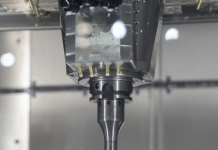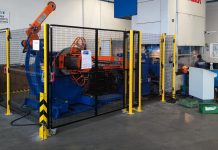Integration? Almost a buzzword in the manufacturing world. Why?
Integration has been a very well used term lately and has been used with different meanings depending on the context. Indeed, considering the meaning of the word (to make whole, perfect what is incomplete or insufficient for a given purpose, adding what is necessary or repairing the defect by appropriate means), it is difficult to think of a negative meaning, but possibly of something difficult to achieve. This is precisely the case in manufacturing and mechanical processing where terms such as integration and automation are increasingly linked and sometimes confused.
Integration promotes competitiveness, proposing qualitatively better products, which are produced in an efficient manner, but the very idea of integration is the result of an ideological path, one could say cultural, which leads to thinking about, and subsequently realizing, the flow of information in such a way that a “chaining” from the idea to the finished product is born. The core: the machining
Production… in the broadest sense
Where is machining done? In production! Certainly, but even this term has acquired a broader meaning: it no longer refers only to the workshop, the environment where by definition, the piece is physically produced, but considers everything that contributes to the creation of the manufactured product, single or assembled component, thus involving more business areas. It goes without saying that when a concept expands, a series of links must be created to ensure synergistic, optimized and quality work, i.e. effective and efficient. These links are provided by electronic and computer tools, some very advanced and sophisticated, others a little less so, which based on more or less customized algorithms and tools, are able to cover the needs of integration of production with the realities that gravitate around it. Today the main problem is how to keep all the disciplines together, making various visions coexist efficiently, from the company-centric vision to the product-centric one, obviously in absolute respect of the market demands. It’s not a case that an efficient collaboration of various systems is precisely what lies at the heart of Industry 4.0!
Obviously, the leading role is played by the machine tool, which has the task of physically “producing” the product, a machine tool that evolves over time, in harmony with the evolution of production logics that focus on efficiency combined with safety (for the workers and the environment). The lack of specialized personnel and the need for unmanned processing are driving towards automated processes, automation integrated with the machine tool and all its devices, to work 24 hours a day, seven days a week: from this point of view, all monitoring, data collection and management activities are fundamental. This involves advanced sensors, visualization, and communication systems, even remotely, with a user-friendly approach to facilitate the task even for non-highly qualified personnel. Forecasts for the future speak of an intelligent workshop, where the machine park is located within a modern production environment, highly digitized and interconnected, absolutely paperless, with the aim of reducing errors due to the passage of paper documents.
Integration and the subsequent automation of processes come from the need to reduce human intervention to a minimum, both due to a lack of suitable professional figures and to the awareness that “human error is always lurking” and naturally, occurs at the most inopportune times. Avoiding the problems of training of employees and the possibility of errors is now feasible thanks to the collection of data and its management, which involves the introduction of automated processes, in an integrated perspective, with an exceptional ally: technology. Technology allows the integration between systems, but it must be clear that this implies a precise management, with a planning that “feeds” the machines, studying, calculating, and predicting in advance, thus avoiding “chase events,” according to a logic of constant stress, as unfortunately become very often.
From idea to virtual model. And to production
The idea is almost a flash of genius. The drafting of the project on a drafting table. Then CAD, first 2D and then 3D. A great help to the designer. Of course, from the first systems to today, things have changed a lot and CAD has been gradually enriched, both in terms of functionality and user interface and has become increasingly more user friendly. However, to a greater extent, CAD has always been the tool of the designer, the one that is entrusted with the study and development of a project.
It’s actually been a while since CAD, although still a modeling system, has had an interesting growth, becoming production engineering software as well. Alongside creation of the virtual model of the manufactured article, the essence to guarantee its production, and complementary to it, there is a sort of parallel world which is the design of the tooling, such as stirrups, jigs, etc. It is indeed a parallel world, but one that is closely linked and integrated into the production process, full of problems that cannot and must not be underestimated, if we do not want to incur serious delays at the very least, with a consequent increase in production costs.
Fortunately, a problem that is potentially overcome today thanks to integration is linked to the different CAD formats, which could make the import/export and manipulation of virtual models from external systems critical with respect to the original model: the use of different systems could require manual intervention to transfer changes made to the project, for example to the relative tooling and/or machining models. Today the problem is largely overcome, opening new frontiers to production engineering, bringing interesting advantages to the company system, which can more easily respect the planning, reducing to a minimum the possibility of errors downstream of the design of the product, allowing, if necessary, timely corrective action.
A further CAD “growth” concerns the implementation of dialogue protocols for applications with additive technology. One of the most important results of Additive Manufacturing concerns the design free from technological limits, related to production aspects, allowing the designer to explore new solutions, consistently with the specifications. The “free” model must then be manipulated with exports, imports, and layer subdivisions, all with a resolution that allows additive manufacturing to meet the required quality standards.
Whether we are talking about conventional machining, or additive technology, CAD in its most evolved form represents the template from which all company solutions must be framed, from those more truly operational to those concerning manufacturing, to work according to a synergic and integrated scheme.
Is the world just pushing a button?
Automation, interconnection, digitization, additive technology…. What will Manufacturing and manufacturing companies be like? No one knows, but there are those who predict an interesting idea: in an integrated system, where automation plays a key role, and where efficiency will be constant and measurable, the production process will require nothing more than a single button. ON/OFF, turned on/turned off. ON/OFF will be the only action permitted to the operator and is intended to be foolproof
Is this really how it’s going to be? It is possible, and in fact automation and the development of mathematical sciences are giving a clear orientation, starting from the study of evolutionary algorithms, able to randomize problems and solutions, which could make the production process managed by a sort of artificial intelligence, able to correct itself and “repair” itself in case of errors or presence of anomalies. If this were the case, it would go far beyond the concept theorized in the 1970s of the Unmanned factory.
Automation and integration
According to the results of periodic surveys conducted on success in manufacturing, the key factor is productivity. In order to remain competitive in an extremely effervescent market, the prevailing driving factor seems to be to invest in operating methods of excellence, with a clear interest in industrial automation which in addition to contributing significantly to the improvement of productivity, allows to keep costs under control while ensuring compliance with current regulations, in terms of labor law.
At the beginning of the 1950s, John Diebold, an American entrepreneur and pioneer of automation, began to develop the concept of automation as the integration of different machines within a single control system. Some designate Diebold himself to have coined the term “automation,” while for others it was Del Harder, Ford’s vice president of manufacturing, who first used the term referring to a new concept of automated handling in the automotive industry. Regardless of how things turned out, the fact remains that Diebold theorized automation as a different way of conceiving and implementing production processes, assuming an integrated system logic, not based on individual machines (or groups of machines), but on the entire production process.
In the late 1950s, Friedrich Pollock, a sociologist, philosopher, and academic of the Frankfurt School, defined automation as the integration of discontinuous or partial processes into a coordinated process, and Northrup as continuous automatic production. The link between integration and automation is therefore a long-standing one, and it is not surprising if even today, there is a tendency to mix and confuse the two terms. In fact, automation can be read as integration, thus relating the two terms, starting from the machine tools themselves, when there is integration between the different levels of production, when manufacturing and management information processes are integrated, when the various company functions are integrated and there is both economic and management control.
Being able to read automation as integration is important because the great technological changes of the third millennium, which are based on the birth of new technical solutions, as well on the integration of processes and the development of new technologies, imply that there is also an integration of management systems and the development of design and management processes that overcome the traditional barriers between functions and different departments. This is also the philosophy behind Industry 4.0.



